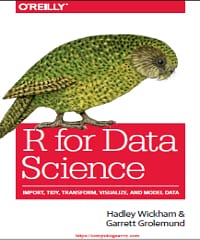 Free download R for Data Science in PDF written by Hadley Wickham and Garrett Grolemund, published by O’Reilly Media, Inc.
Free download R for Data Science in PDF written by Hadley Wickham and Garrett Grolemund, published by O’Reilly Media, Inc.
According to the Authors, “Data science is an exciting discipline that allows you to turn raw data into understanding, insight, and knowledge. The goal of R for Data Science is to help you learn the most important tools in R that will allow you to do data science. After reading this book, you’ll have the tools to tackle a wide variety of data science challenges, using the best parts of R. This book Introduces you to R, RStudio, and the tidy verse, a collection of R Packages designed to work together to make data science fast, fluent, and fun.
What You Will Learn
Data science is a huge field, and there’s no way you can master it by reading a single book. The goal of this book is to give you a solid foundation in the most important tools. Our model of the tools needed in a typical data science project.
First you must import your data into R. This typically means that you take data stored in a file, database, or web API, and load it into a data frame in R. If you can’t get your data into R, you can’t do data science on it!
Once you’ve imported your data, it is a good idea to tidy it. Tidying your data means storing it in a consistent form that matches the semantics of the dataset with the way it is stored. In brief, when your data is tidy, each column is a variable, and each row is an observation. Tidy data is important because the consistent structure lets you focus your struggle on questions about the data, not fighting to get the data into the right form for different functions.
Once you have tidy data, a common first step is to transform it. Transformation includes narrowing in on observations of interest (like all people in one city, or all data from the last year), creating new variables that are functions of existing variables (like computing velocity from speed and time), and calculating a set of summary statistics (like counts or means). Together, tidying and transforming are called wrangling, because getting your data in a form that’s natural to work with often feels like a fight!
Once you have tidy data with the variables you need, there are two main engines of knowledge generation: visualization and modeling. These have complementary strengths and weaknesses so any real
analysis will iterate between them many times.
Visualization is a fundamentally human activity. A good visualization will show you things that you did not expect, or raise new questions about the data. A good visualization might also hint that you’re asking the wrong question, or you need to collect different data. Visualizations can surprise you, but don’t scale particularly well because they require a human to interpret them.
Table of Contents
- Data Visualization with ggplot2
- Workflow: Basics
- Data Transformation with dplyr
- Workflow: Scripts
- Exploratory Data Analysis
- Workflow: Projects
- Tibbles with tibble
- Data Import with readr
- Tidy Data with tidyr
- Relational Data with dplyr
- Strings with stringr
- Factors with forcats
- Dates and Times with lubridate
- Pipes with magrittr
- Functions
- Vectors
- Iteration with purr
- Model Basics with modelr
- Model Building
- Many Models with purr and broom
- R Markdown
- Graphics for communication with ggplot2
- R Markdown Formats
- R Markdown Workflow
- Index
Free download R for Data Science in PDF written by Hadley Wickham and Garrett Grolemund from following download links.
Password for Download Links: ComputingSavvy
File Size: 33 MB Pages: 520 Please Read Disclaimer
You may also like to download Data Science from Scratch (First Principles With Python)
P.S: If the download link(s) is/are not working, kindly drop a comment below, so we’ll update the download link for you